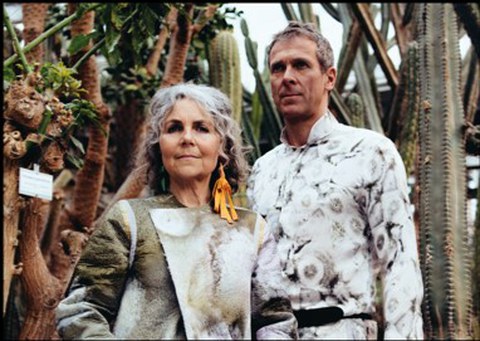24.09.2019
Wissenschaft zieht an

Ines und Holm Sommer zeigen die durch Lichtmikroskopie entstandenen Muster auf der Kleidung
Nachhaltiges Handeln, Fairtrade, biologische Landwirtschaft, erneuerbare Energien – das Thema Klimaschutz und Nachhaltigkeit bestimmen auch 2019 den öffentlichen Diskurs in Deutschland und zeigen, dass die Frage der Ressourcennutzung so aktuell und bedeutend ist wie nie. Auch in der Modebranche gewinnt das Thema Nachhaltigkeit immer mehr an Bedeutung, zumal immer mehr Verbraucher Wert auf transparente Handelswege, ressourcenschonendes Arbeiten und faire Arbeitsbedingungen legen. Immer mehr Modeunternehmen setzen auf nachhaltige und ökologische Rohstoffe, doch produziert wird meistens in Entwicklungsländern mit langen Handelswegen und unter schlechten Arbeitsbedingungen in den Fabriken.
Wiete Sommer, Mode - und Textildesignerin aus Dresden, ist Absolventin der HTW Berlin. Sie möchte faire Mode kreieren und den Konsumenten größtmögliche Transparenz bieten. Die junge Designerin arbeitet in einem gemeinsamen Projekt mit der Light Microscopy Facility der CMCB Technologieplattform des BioDIP Dresden zusammen. Mit Hilfe lichtmikroskopischer Aufnahmen des BioDIP entwirft die Designerin Digitaldrucke die anschließend auf Stoff gedruckt werden. Die Modekollektion wird in Deutschland produziert. Auch über Alternativen zu Baumwolle hat Wiete Sommer bereits nachgedacht und mit Produzenten geredet: „Materialien wie Hanf oder Algen eignen sich hervorragend, es sind nachwachsende Rohstoffe und innovative Materialien der Zukunft“, so Frau Sommer.
Ihr Projekt sieht die Designerin als Chance, Wissenschaft und Kunst zusammenzubringen und auf eine kreative Art zu zeigen, wie aus analytischer Wissenschaft und modernem Design ein neues Produkt entstehen kann. So bedruckte sie Kleidung bereits mit Aufnahmen von Schimmelpilzen. „Mir ist es sehr wichtig, eine starke Natürlichkeit zu zeigen und das Ästhetische im scheinbar weniger Ästhetischen zu finden“, erläutert Frau Sommer. So sieht sie ihre Mode zwar als marktfähiges Produkt, jedoch mit großem künstlerischen Anspruch. Sie ist auf dem besten Weg bis Ende nächsten Jahres ihre Kollektion in Kleinserien zu produzieren. „Denkbar ist eine Präsentation im Rahmen der Langen Nacht der Wissenschaft und auch Endverbrauchermessen sind im Gespräch".
Aktuell laufen die Verhandlungen der Lizenzverträge bezüglich der Bildrechte. „Ich bin immer offen für neue Ideen und ich würde mich freuen weiterhin branchenübergreifend mit anderen Menschen zusammenzuarbeiten“, betont die Designerin. Frau Sommer stammt aus einer Künstlerfamilie aus Radebeul, ihre Eltern und Schwester bezieht sie in ihre Projekte ein und stimmt sich mit ihnen ab. Auch als Fotomodels ließen sich ihre Eltern für ihr neues Projekt bereits ablichten. Die Arbeit mit Fotografien bietet viel Gestaltungsspielraum, auch Siebdruckverfahren kann sich die Designerin für ihr nächstes Projekt gut vorstellen. „Mein Ziel ist es, Wissen durch Mode als Bildträger weiterzugeben und zu zeigen, wie ästhetisch Wissenschaft sein kann. Ich möchte Nachhaltigkeit visualisieren, neue Denkanstöße liefern und eine weitere Alternative zu konventionell gefertigter Massenware anbieten".
